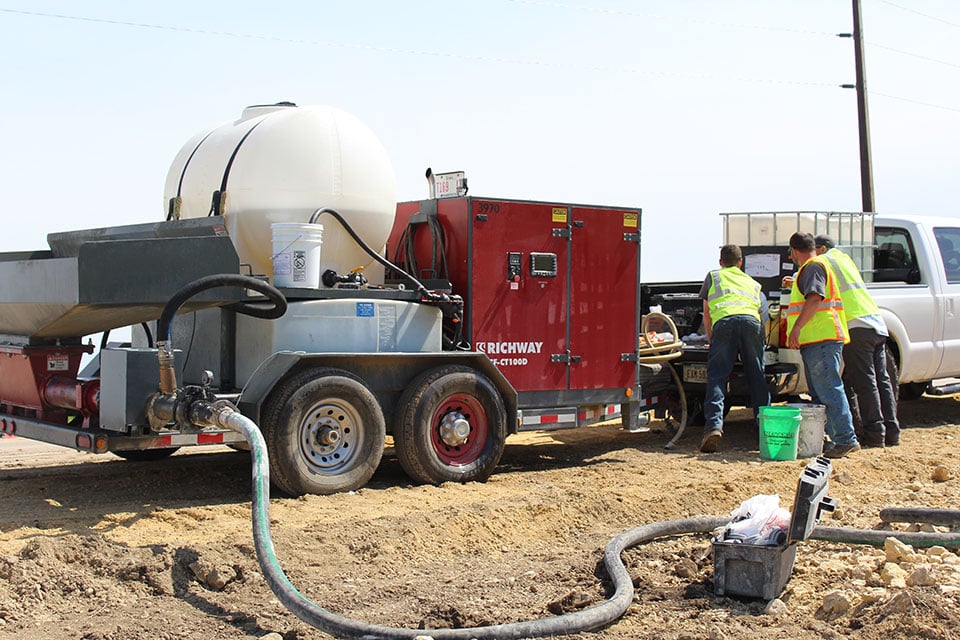
In this video you will learn the basics of cellular concrete including what it is, common uses, mix designs, and the importance of quality control. We will also go over a few cellular concrete projects Richway Industries has been involved in and show you our Mix Design Calculator that can be downloaded from our website. To download the calculator or to learn more about cellular concrete visit: https://richway.com/mix-design-calculator/
If you are just getting started with cellular concrete or if you have basic questions about cellular concrete, here is a great place to get started. We will explain what cellular concrete is, what applications it is used for, and frequently asked questions. If you still have questions after reading this page, give us a call to discuss your questions or check out our other resource pages to learn more about cellular concrete.
Low density cellular concrete, as defined by ACI chapter 523.1, is concrete made with hydraulic cement, water, and preformed foam to form a hardened material having an oven-dry density of 50 pounds per cubic foot (PCF) or less.
Although the ACI definition specifies low density cellular concrete with a density lower than 50 PCF, cellular concrete can range in density from 20 PCF to 120 PCF.
In a broader sense, any cementitious slurry, or cementitious material that uses an externally generated foam to increase air content above 10%, could be considered cellular concrete. Cellular concrete may go by other names including foam cement, foamed concrete, or lightweight flowable fill.
Although there are a number of lightweight cementitious materials, the key differentiating factor between cellular concrete and other lightweight cementitious materials is the use of externally generated foam to reduce the density. Probably the closest material to cellular concrete is aerated autoclaved concrete (AAC).
The primary differences are the processes used to create the air within the material and the required equipment. AAC uses a chemical reaction within the slurry itself to generate air voids for density reduction. However, producing cellular concrete with externally generated foam provides a more versatile material at a fraction of the capital costs required for equipment.
Cellular concrete has many uses and does not have one singular advantage. Depending on the application, it may be chosen for its thermal and acoustical insulative properties, pumpability and flowability, ease of handling due to its light weight, or as a cost saving alternative to fill materials. Throughout the world, cellular concrete is used in building and construction applications such as roof decks and floor decks, and geotechnical applications such as annular space filling in slip lining and void fill abandonment. Cellular concrete can also be found in architectural and precast applications. Below are many of the more common applications for cellular concrete; however, it’s not an exhaustive list.
Void Filling: Sinkholes, wells, tunnels, cisterns, abandoned utility pipes, annular grouting. Flows easily and provides reduced weight on soil.
Soil Remediation: When poor subsoil conditions exist, cellular concrete can be used to create a strong base while reducing burden on subsoils.
Utility Trench Fill: Protects and supports utility lines and reduces or eliminates need for compaction.
Flowable Fill/Geofoam Alternative: Any applications where flowable fill or geofoam blocks are being used, cellular concrete is an excellent alternative, and in many cases the preferred material choice.
Culvert Trench Fill: Prevents later soil settlement and subsequent dips in road.
Bridge/Overpass Abutment Fill: Eliminates post-construction settling. Because cellular concrete does not need compaction, it won’t compress over time, creating a “dip” in a bridge or overpass approach. Additionally, lateral loads against the existing abutment are essentially eliminated.
Retaining Wall/MSE Wall Backfill: The lateral load reduction is the primary advantage. Cellular concrete can also greatly reduce potential damage to the geogrid during the backfill process.
Fence Panels Along Highways: For sound control and visual blocking. Cost savings potential due to weight savings.
Crash Barriers/Energy Absorption: Pre-cast variable density cubes or pour on location.
Floor Decks: Reduces structural weight while maintaining quality of concrete floor. Used for leveling and replacement of gypsum-based mixes.
Roof Decks: Reduces weight and provides thermal and sound insulation. Moderate slopes are possible.
Precast Specialties: Reduces weight and cost. Reduces transport costs/allows more pieces per truckload. Easier installation.
Thermal Backfill and Sub-slab Fill: Provides thermal insulation and water resistance, and reduces hydrostatic lateral load on foundation.
Interior Walls: Cast on site tilt-up or panel assemblies. Reduces weight and cost below full density concrete wall. More soundproof and fire resistant than stud wall.
Retaining Wall Base: Proper mix design will be self-leveling and can greatly speed base construction and improve load capacity.
Sidewalks, Patios, and Porch Decks: Reduces weight and cost.
Carved Concrete Sculptures: Cellular concrete in the 40-60 PCF range can be carved and shaped with chain saws, hand tools, and other methods to create artwork from a unique medium.
If you have any questions or need help about a product, feel free to contact us Mon – Fri 8-5pm CST.
If you have any questions or need help about a product, feel free to contact us Mon – Fri 8-5pm CST.
Website Designed by Running Robots
"*" indicates required fields